| |||||
| Decades: | |||||
|---|---|---|---|---|---|
| See also: | |||||
The following lists events that happened during 1970 in Somalia .
| |||||
| Decades: | |||||
|---|---|---|---|---|---|
| See also: | |||||
The following lists events that happened during 1970 in Somalia .

The Somali Armed Forces are the military forces of the Federal Republic of Somalia. Headed by the president as commander-in-chief, they are constitutionally mandated to ensure the nation's sovereignty, independence and territorial integrity.
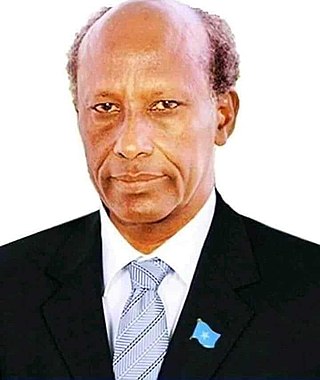
Mohamed Farrah Hasan Garad, popularly known as General Aidid or Aideed, was a Somali military officer and warlord.

Mohammed Siad Barre was a Somali military officer, politician and revolutionary who served as the third president of Somalia from 21 October 1969 to 26 January 1991.

Abdiqasim Salad Hassan, also known as Abdiqasim Salad, is a Somali politician who served as the fifth President of Somalia from 2000 to 2004. He helped found the Transitional National Government and previously served as Minister of Interior in the government of Siad Barre.

The Somali Democratic Republic was a socialist state in Somalia that existed from 1969 to 1991.
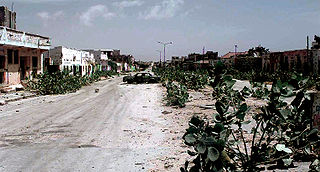
The Somali Civil War is an ongoing civil war that is taking place in Somalia. It grew out of resistance to the military junta which was led by Siad Barre during the 1980s. From 1988 to 1990, the Somali Armed Forces began engaging in combat against various armed rebel groups, including the Somali Salvation Democratic Front in the northeast, the Somali National Movement in the Somaliland War of Independence in the northwest, and the United Somali Congress in the south. The clan-based armed opposition groups overthrew the Barre government in 1991.

The Ogaden is one of the major Somali clans in the Horn of Africa.

The Somaliland National Armed Forces are the military services of the Republic of Somaliland. The Somaliland National Armed Forces consist of the Somaliland National Army, the Somaliland Coast Guard, the Somaliland Police Force, the Somaliland Custodial Corps, the Somaliland Immigration and Border Control and the Somaliland Fire Brigade. There is no air force. The Armed Forces is under the command of President Muse Bihi Abdi, who is the Commander-in-chief. Minister of Defence Dr. Rooble Muuse Abdi is the designated minister that oversees the armed forces.
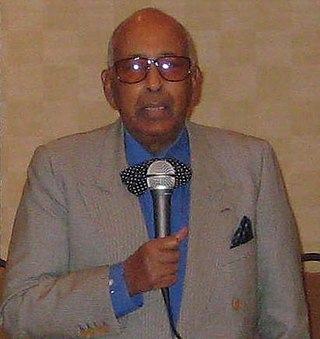
Abdirahman Jama Barre was a Somali politician. He twice served as the Minister of Foreign Affairs of the Somali Democratic Republic, and later as the Minister of Finance. He was the first Deputy Prime Minister of Somalia.
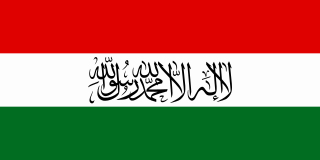
The Somali National Movement was one of the first and most important organized guerilla groups and Mujahideen groups that opposed the Siad Barre regime in the 1980s to the 1990s, as well as being the main anti-government faction during the Somaliland War of Independence. The organisation was founded in London, England, on April 6, 1981 by Hassan Isse Jama, Hassan Adan Wadadid, and Ahmed Mohamed Gulaid and other former Somali diplomats, who stated that initially the group's purpose was to overthrow the Siad Barre regime.
The Somali National Alliance was a major politico-military faction formed on 16 June 1992 by four different rebel groups that had been in opposition to the regime of former Somali President Mohamed Siad Barre. The SNA was the first major inter-clan and inter-factional political alliance and was considered to be among the most powerful factions of the Somali Civil War. The alliance would most notably face off against the second phase of the United Nations Operation in Somalia in the latter half of 1993.
The Somali Rebellion was the start of the Somali Civil War that began in the 1970s and resulted in the collapse of the Somali Democratic Republic in 1991. The rebellion effectively began in 1978 following a failed coup d’état and President Siad Barre began using his special forces, the "Red Berets", to attack clan-based dissident groups opposed to his regime. Backed by Ethiopia, the two earliest rebel factions, the Somali Salvation Democratic Front (SSDF) and the Somali National Movement (SNM) began attacks during the against government forces during the early 1980s.
The Somali National Front (SNF) was a politico-military organization that operated in southern Somalia during the Somali Civil War and represented one of the major factions involved in the conflict.
Many factions opposed to Siad Barre set aside tribal and political differences to unite in purpose to overthrow his regime. After the collapse of Siad Barre's government in 1991 the nation fell into a long period of increasingly chaotic conflict between forces of clans, militias, warlords, separatist, religious functions and rebellion movements, other nations, and even the United Nations peacekeepers.
Over the course of the Somali Civil War, there have been many revolutionary movements and militia groups run by competing rebel leaders which have held de facto control over vast areas within Somalia.
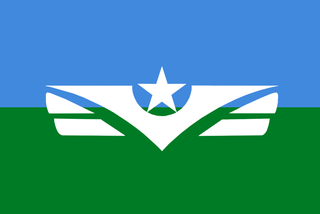
The Somali Air Force is the air force of Somalia. Called the Somali Aeronautical Corps (SAC) during its pre-independence period (1954–1960), it was renamed as Somali Air Force (SAF) after Somalia gained independence in 1960. Ali Matan Hashi, Somalia's first pilot and person principally responsible for organizing the SAF, was its founder and served as its the country's first air chief. At one point, the Somali Air Force had the strongest airstrike capability in the Horn of Africa. But by the time President Siad Barre fled Mogadishu in 1991, it had completely collapsed. The SAF headquarters was technically reopened in 2015.
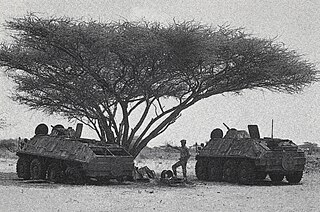
The Ethiopian–Somali Border War occurred from June 1982 to August 1983 when Ethiopia, sending a 10,000-man invasion force backed by warplanes and armoured units, supported by thousands of Somali Salvation Democratic Front (SSDF) rebels, invaded central Somalia.

The Isaaq genocide, also known as the Hargeisa Holocaust, was the systematic, state-sponsored genocide of Isaaq civilians between 1987 and 1989 by the Somali Democratic Republic, under the dictatorship of Siad Barre, during the Somaliland War of Independence. The number of civilian deaths in this massacre is estimated to be between 50,000 and 100,000, according to various sources, whilst local reports estimate the total civilian deaths to be upwards of 200,000 Isaaq civilians. The genocide, which escalated after the Somali National Movement (SNM)'s 1988 Northern Somalia offensive, also included the levelling and complete destruction of the second and third largest cities in the Somali Republic, Hargeisa and Burao, respectively, and had caused up to 500,000 Somalis of the region, primarily of the Isaaq clan, to flee their land and cross the border to Hartasheikh in Ethiopia as refugees in what was described as "one of the fastest and largest forced movements of people recorded in Africa", which resulted in the creation of the world's largest refugee camp then (1988), with another 400,000 being displaced. The scale of destruction led to Hargeisa being known as the 'Dresden of Africa'. The killings happened during the Somali Civil War and have been referred to as a "forgotten genocide".

The 1969 Somali coup d'état was a bloodless military takeover of the Somali Republic on 21 October 1969, led by Somali National Army officers of the Supreme Revolutionary Council under General Siad Barre. After the assassination of President Abdirashid Shermarke in Las Anod, the Somali National Army under Barre's command stormed Mogadishu, seized key government buildings, and demanded the resignation of the country's leaders. The coup deposed acting President Sheikh Mukhtar Hussein and Prime Minister Mohammad Egal, ushering in a 21-year military rule under Barre and the establishment of an authoritarian government that lasted until 1991.

The Somaliland War of Independence was a rebellion waged by the Somali National Movement (SNM) against the ruling military junta in Somalia led by General Siad Barre lasting from its founding on 6 April 1981 and ended on 18 May 1991 when the SNM declared what was then northern Somalia independent as the Republic of Somaliland. The conflict served as the main theater of the larger Somali Rebellion that started in 1978. The conflict was in response to the harsh policies enacted by the Barre regime against the main clan family in Somaliland, the Isaaq, including a declaration of economic warfare on the clan-family. These harsh policies were put into effect shortly after the conclusion of the disastrous Ogaden War in 1978.